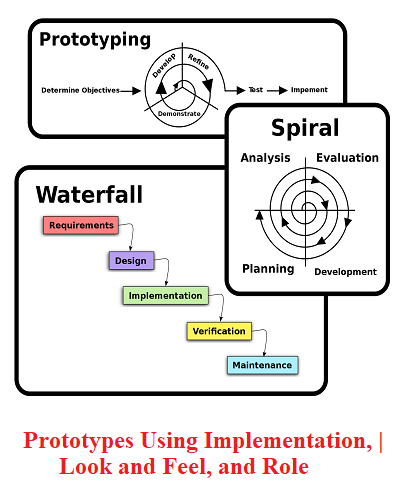Admin
مدير المنتدى


عدد المساهمات : 18864
التقييم : 35108
تاريخ التسجيل : 01/07/2009
الدولة : مصر
العمل : مدير منتدى هندسة الإنتاج والتصميم الميكانيكى
 |  موضوع: مشروع تخرج بعنوان An Analysis of Early Stage Prototypes Using Implementation, Look and Feel, and Role موضوع: مشروع تخرج بعنوان An Analysis of Early Stage Prototypes Using Implementation, Look and Feel, and Role  الأحد 20 نوفمبر 2022, 9:27 pm الأحد 20 نوفمبر 2022, 9:27 pm | |
| 
أخواني في الله
أحضرت لكم
مشروع تخرج بعنوان
An Analysis of Early Stage Prototypes Using Implementation, Look and Feel, and Role
by
Lauren R. Hernley
Submitted to the Department of Mechanical Engineering
In Partial Fulfillment of the Requirements for the Degree of
Bachelor of Science
at the
Massachusetts Institute of Technology
The author hereby grants to MIT permission to reproduce and to
distribute publicly paper and electronic copies of this thesis document in whole or in part
in any medium now known or hereafter created.

و المحتوى كما يلي :
Table of Contents
1. Introduction .7
2. Background 7
2.1 Prototype classification 7
2.2 Additional prototype characterization .9
3. Methods .9
3.1 The context .9
3.2 Evaluating the prototypes 10
4. Results and discussion .11
5. Conclusions and future work .24
References .25
Appendix A – Prototype questionnaire
List of Figures
Figure 2-1: What Prototypes Prototype (Houde and Hill, 1997) triangle prototype classification model . 8
Figure 4-1: Sketch model prototype of the biodiesel conversion process .12
Figure 4-2: Sketch model prototype of the biodiesel liquid density separator – an LED sensor and
receiver mounted in a foamcore channel with two vials of distinct liquids (one of water and one of
biodiesel) passing through the sensor field 12
Figure 4-3: Tourné-Do Blade sketch model prototype - a single thin blade on a track profiling a tourné
cut. It is hand-powered and uses a single pin to skewer and hold the pre-stamped stock vegetable .13
Figure 4-4: Tourné-Do Iris sketch model prototype - a seven blade iris diaphragm tourné cutting
mechanism 14
Figure 4-5: Wilbur Wake Up sketch model prototype - demonstrates the activation of toaster heating
elements using digital signal triggering .14
Figure 4-6: CoasterBot sketch model prototype - a remote controlled coaster shaped robot for delivering
drinks to patrons at a bar. It is laser cut out of acrylic .15
Figure 4-7: Tourné-Do Longitudinal mock-up prototype – uses a wire cutting mechanism with handpowered rotary motion and two pins to secure the pre-stamped stocked vegetable at both ends .16
Figure 4-8: CoasterBot mock-up prototype – autonomously controlled by an Arduino microcontroller
and IR sensors through wall following navigation. The chassis is 3D printed instead of laser cut .17
Figure 4-9: SushiBot technical review prototype – autonomously controlled by an Arduino
microcontroller and IR sensors through line following navigation. SushiBot has a 3D printed chassis, a
custom PCB, and plate detection capability with several response dances .18
Figure 4-10: Noribo final presentation prototype – the next generation of SushiBot from the technical
review. Noribo was manufactured in the same way and with the same components as its predecessor,
but hardware and aesthetic improvements were made 19
Figure 4-11: The Houde and Hill (1997) triangle model showing the classification of all ten prototypes .19
Figure 4-12: Houde and Hill (1997) triangle model showing the product cycle progression of CoasterBot
to Noribo .20
Figure 4-13: Notional relationship between the number of design questions answered and time. .21
Figure 4-14: graphs (a) and (b) show the relationship between level of fidelity and time, the relationship
between level of resolution and time, respectively .22
Appendix A – Prototype questionnaire .26
An Analysis of Early Stage Prototypes Using Implementation, Look
and Feel, and Role
by
Lauren R. Hernley
Submitted to the Department of Mechanical Engineering
On May 6, 2011 in partial fulfillment of the requirement for the degree of
Bachelor of Science in Mechanical Engineering
Abstract
Identifying the purpose of a prototype is central to making informed decisions about the kind of
prototype to build. Houde and Hill (1997) propose a model for classifying prototypes according to
their purpose and the design questions they answer. Since this model was created for user
interaction design, it has never been applied to physical prototypes on a large scale or to a
progression of prototypes through the product development cycle. Ten physical prototypes from an
MIT mechanical engineering senior capstone design course are evaluated according to the Houde
and Hill (1997) model. With only a few challenges, the model is found to be applicable to physical
prototypes, providing insight into the nature of physical prototyping, the product development
cycle, and MIT’s senior design course. In the process, a notional relationship between the
progression of the product development cycle and the number of design questions answered is
proposed.
Thesis Supervisor: Maria C. Yang
Associate Professor of Mechanical Engineering and Engineering Systems
كلمة سر فك الضغط : books-world.net
The Unzip Password : books-world.net
أتمنى أن تستفيدوا من محتوى الموضوع وأن ينال إعجابكم
رابط من موقع عالم الكتب لتنزيل مشروع تخرج بعنوان An Analysis of Early Stage Prototypes Using Implementation, Look and Feel, and Role
رابط مباشر لتنزيل مشروع تخرج بعنوان An Analysis of Early Stage Prototypes Using Implementation, Look and Feel, and Role 
|
|







